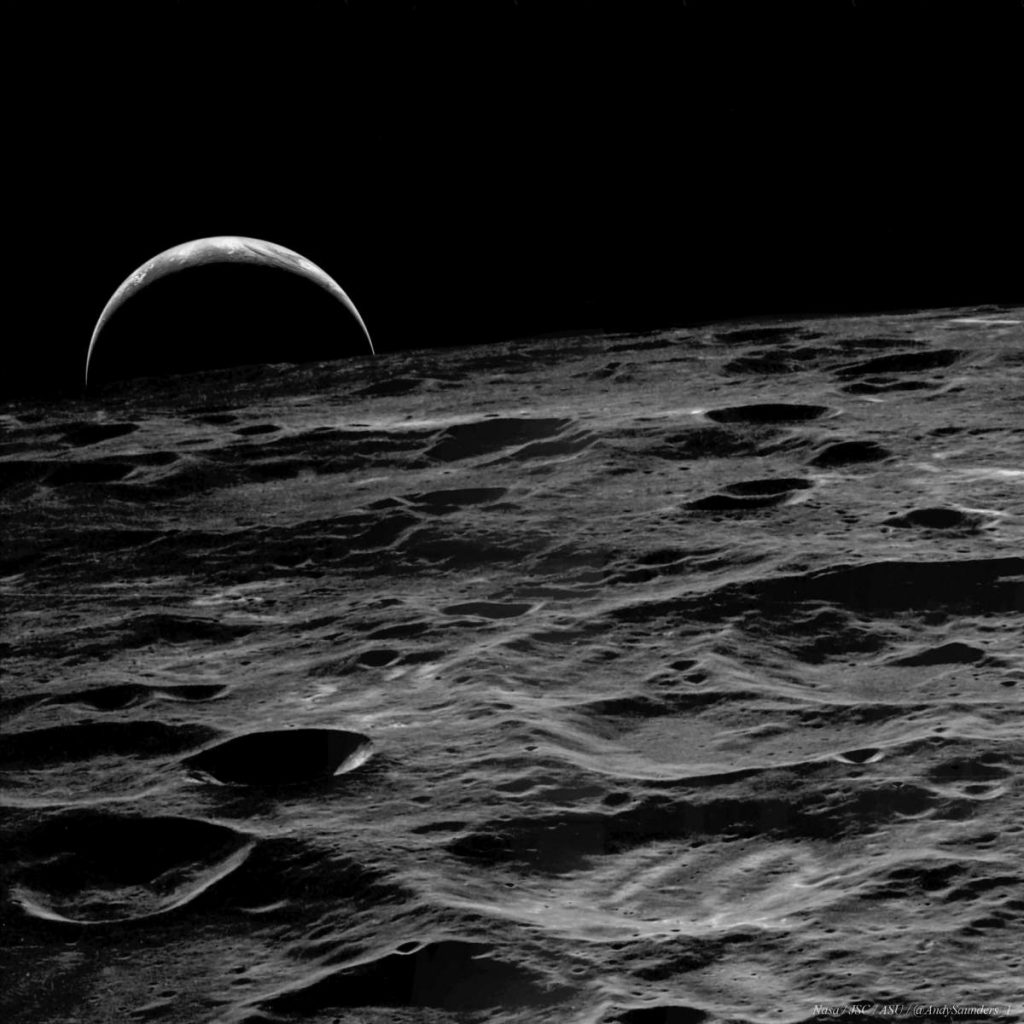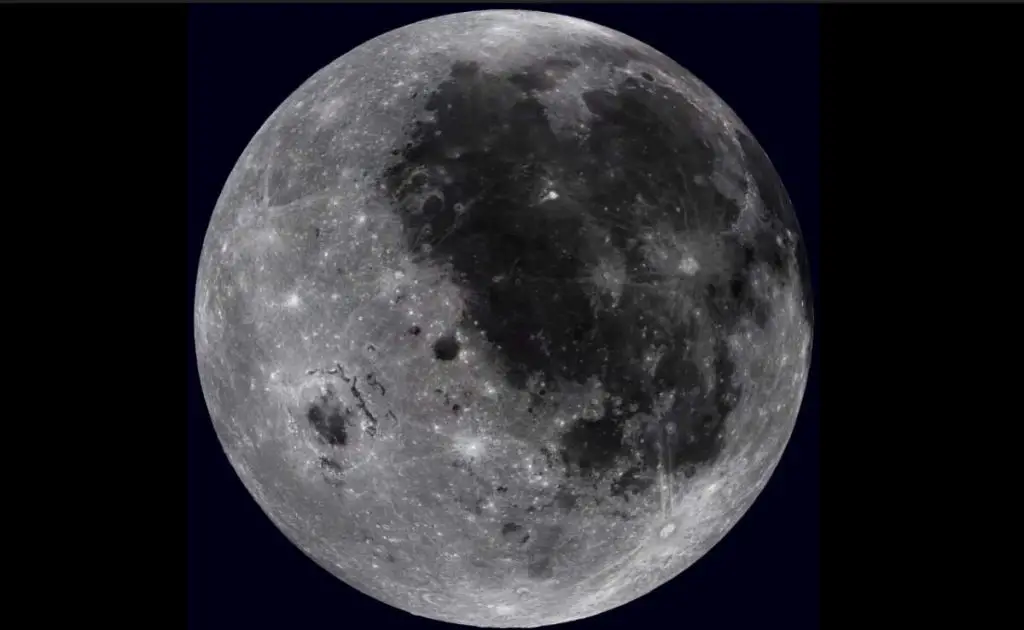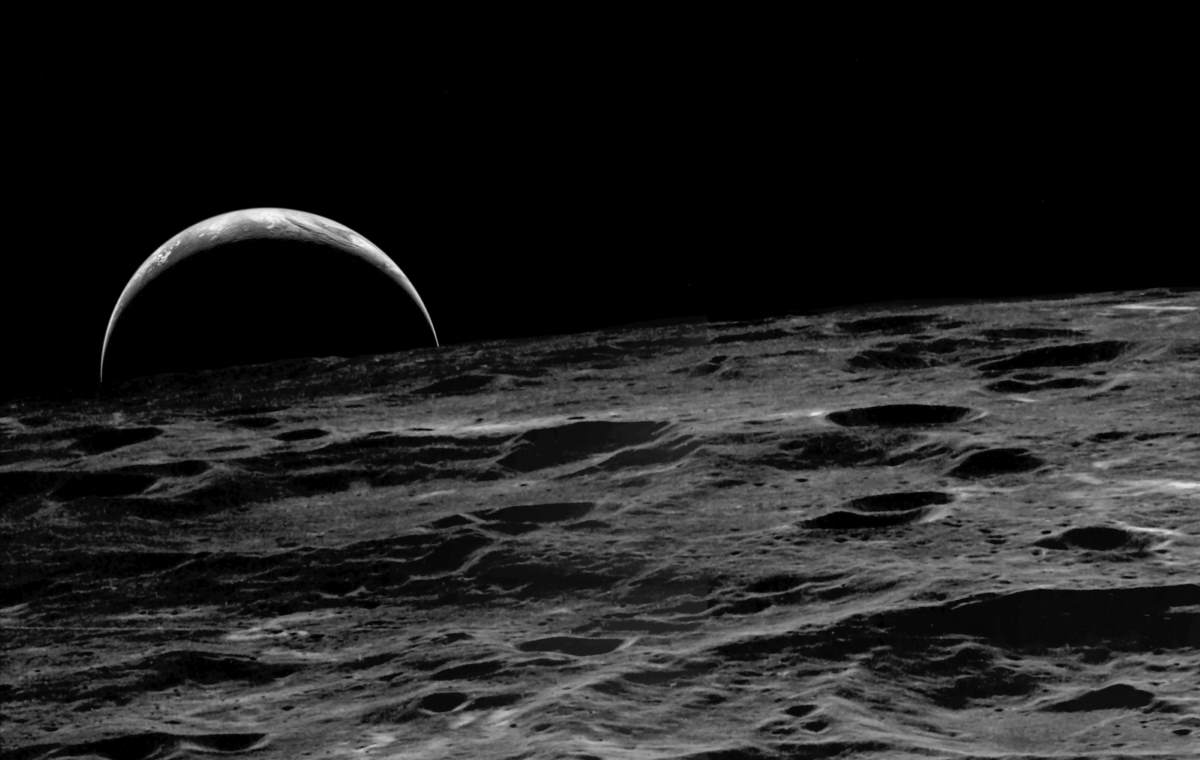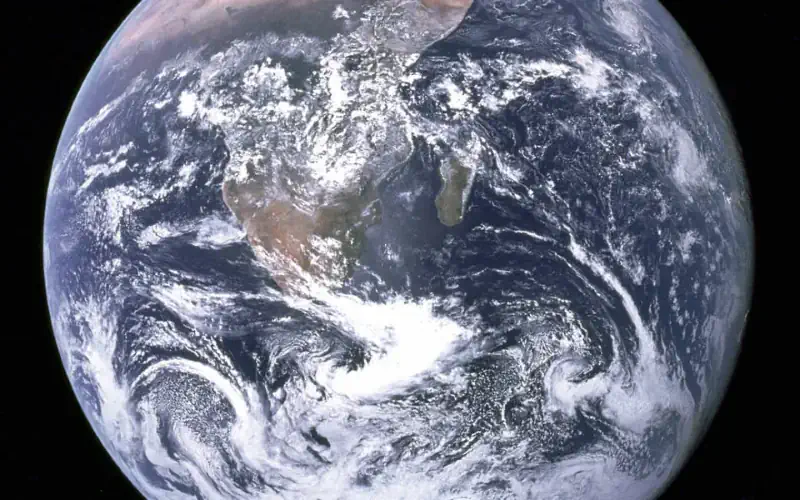NASA’s Astronomy Picture of the Day (APOD) for February 1, 2020: a crescent Earth rising over the Moon, seen from Apollo 14 on February 6, 1971. This photo is not as famous as the Apollo 8 Earthrise, or the Blue Marble, but it has such an eerie beauty.
The crescent Earth: a beauty
When leaving lunar orbit in February 1971, the crew of Apollo 14 (Commander Alan Shepard, Command Module Pilot Stuart Roosa, and Lunar Module Pilot Edgar Mitchell) watched this Earthrise from their command module Kittyhawk. With Earth’s sunlit crescent just peaking over the lunar horizon, the cratered terrain in the foreground is along the lunar farside. Of course, while orbiting the Moon, the crew could watch Earth rise and set, but the Earth hung stationary in the sky over Fra Mauro Base, their landing site on the lunar surface.

Rock samples brought back by the Apollo 14 mission included a 20-pound (about 9 kg) rock nicknamed Big Bertha, later determined to contain a likely fragment of a meteorite from planet Earth. It was ejected from Earth from about 4.0-4.1 billion years ago, thus it is probably the oldest rock sample of our planet ever found.
A large asteroid or comet impact jettisoned material into space, where it collided with the surface of the Moon.
Around that time, the Moon was much closer to the Earth than it is today – it was some 80,000 miles away (around 129,000 km). Today, the average distance between Earth and the Moon is 384,400 km (238,855 miles). As a result, our satellite was 2.8 times larger in the sky than it is today. So, the material exchange between the Moon and Earth was much easier than today.
Apollo 14
Apollo 14 Crew:
- Alan B. Shepard Jr., Commander
- Edgar D. Mitchell, Lunar Module Pilot
- Stuart A. Roosa, Command Module Pilot
The primary objectives of the Apollo 14 mission were:
- to explore the Fra Mauro region centered around the deployment of the Apollo Lunar Surface Scientific Experiments Package, or ALSEP
- lunar field geology investigations
- collection of surface material samples for return to Earth
- deployment of other scientific instruments not part of ALSEP
- orbital science involving high-resolution photography of candidate future landing sites
- photography of deep-space phenomena, such as zodiacal light and gegenschein
- communications tests using S-band and VHF signals to determine reflective properties of the lunar surface
- engineering and operational evaluation of hardware and techniques
- tests to determine variations in S-band signals
- and photography of surface details from 60 nautical miles in altitude.
Landing site: the Fra Mauro crater
The Fra Mauro crater is named after Italian geographer Fra Mauro (c.1400-1464), an Italian cartographer who lived in the Republic of Venice. Around 1450, he created the most detailed and accurate map of the world up until that time, the Fra Mauro map.

Apollo 14 launched on January 31, 1971, at 4:03 p.m. EST. At approximately 3:41 p.m. ground elapsed time, or GET, difficulties were experienced in docking with the lunar module or LM, and six attempts were required before a “hard dock” was achieved. An in-flight televised inspection of the docking mechanism revealed no apparent reason for the malfunction and the system appeared to be functioning normally.
Prior to the powered descent initiation, or PDI, for the Antares landing, a short in the LM computer abort switch was discovered, which could have triggered an undesired abort during the LM’s descent. On February 5, Antares made the most precise landing to date, approximately 87 feet (26.5 meters) from the targeted landing point. The landing point coordinates were 3 degrees, 40 minutes, 27 seconds south and 17 degrees, 27 minutes, 58 seconds west, midway between the Doublet and Triplet craters in the hilly uplands of the Fra Mauro crater, and about 110 miles (177 km) east of the Apollo 12 landing site.

Related: Amazing Moon facts
Due to communications system problems, the first period of extravehicular activity, or EVA, began almost one hour later than scheduled with Commander Alan Shepard setting foot on the lunar surface at 114 hours, 31 minutes GET. The first of the two EVA periods included ALSEP deployment and lasted four hours, and 49 minutes.
The second EVA on February 6 began when the LM egress hatch was opened at 4:15 a.m. EST. During this EVA, Shepard and Edgar Mitchell moved more than half a mile from their LM, conducting selenological investigations, collecting samples, and attempting to reach the rim of the Cone crater, approximately 300 feet (91 meters) above the landing site.
NASA personnel monitoring the EVA estimate that the two astronauts were within 50 to 75 meters (164 to 246 feet) of the crater rim when they were advised by mission control to collect samples at that spot and begin their traverse back to the LM. The second EVA lasted four hours, and 35 minutes, resulting in a new mark for EVA time by a lunar landing crew: nine hours, 24 minutes. Shepard set a new distance-traveled record on the lunar surface of approximately 9,000 feet (2743 meters).
During the two traverses, the astronauts collected 94 pounds (42.6 kg) of rocks and soil for return to Earth. The samples were scheduled to go to 187 scientific teams in the United States, as well as 14 other countries for study and analysis.
Orbital science activities were conducted by Stuart Roosa during the lunar surface activities period. He experienced some difficulties with the high-resolution, motion-compensating Hycon Lunar Topographic Camera while attempting to photograph the Descartes area, the landing site planned for Apollo 16.
The liftoff of Antares from the lunar surface took place precisely on schedule. Rendezvous and docking occurred only two minutes later than scheduled. The command module Kitty Hawk splashed down safely in the Pacific Ocean at 4:05 p.m. EST on February 9, exactly nine days and two minutes after launch.
The actual landing point was only 1.02 nautical miles off its targeted point of about 765 nautical miles (about 1417 km) south of Samoa, and four miles from the prime recovery ship, the USS New Orleans. The mission duration from liftoff to splashdown was 216 hours, two minutes.
Sources
- Apollo 14 on Wikipedia
- Apollo 14 mission page on the NASA website
- Fra Mauro on Wikipedia
- Fra Mauro crater on Wikipedia
- Space Shuttle Endeavour’s Touchdown Meets Columbia’s Salute [An amazing photo from the past] - February 29, 2024
- Moon Landings: All-Time List [1966-2024] - February 23, 2024
- From Orbit to Ordinary: 10 Earthly Applications of Space Technology - January 23, 2024


